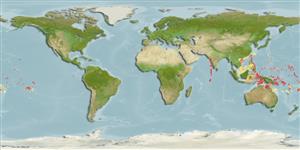Sagittoidea |
Aphragmophora |
Sagittidae
Environment: milieu / climate zone / depth range / distribution range
Ecology
Pelagic; brackish; depth range 74 - 150 m (Ref. 97338). Tropical; 35°N - 8°S, 130°E - 156°E
Pacific Ocean.
Length at first maturity / Size / Weight / Age
Maturity: Lm 0.6 range ? - ? cm Max length : 0.8 cm BL male/unsexed; (Ref. 3682); common length : 0.5 cm TL male/unsexed; (Ref. 97339)
Small chaetognath with a firm, opaque and flexible body. Muscles are strong. Lateral fields are narrow. Width of body is of same size from head to caudal septum. Intestinal diverticula is present. Head is of normal size with an inconspicuous neck. Tail segment constitutes 25 to 29 per cent of total length of animal. Eyes are large, with pigment in a large spot formed by three branches toward centre and two shorter ones toward sides. Collarette is absent. Corona ciliata seen at from neck region, extending to about midway to ventral ganglion. Ventral ganglion is large for the size of the animal. nterior fins are slightly shorter than posterior fins and begin just behind posterior end of ventral ganglion. A rayless zone is absent and at anterior end a small part of fin has rays perpendicular to body walls. Posterior fins are triangular in shape extending to seminal vesicles with widest region at the tail segment. About two thirds of the length of posterior fin is on tail. Rayless zone is absent and in the most anterior part there is a small region with rays directed perpendicular to body walls. Distance between paired fins is only about 2.8 per cent of total length. Tail fin is long.
This is a coastal neritic species. It is carnivorous; feeds on crustaceans, hydromedusae, other chaetognaths and fish larvae (Ref. 97339). Mean latitude of occurrence = 10.75 (N); Present in China (Ref. 125708).
Life cycle and mating behavior
Maturity | Reproduction | Spawning | Eggs | Fecundity | Larvae
Hermaphrodite; male gonads located in the tail segment and the female in the posterior part of the trunk. Fertilization occurs through copulation (Ref. 97339).
Pierrot-Bultz, A. 2004. (Ref. 3682)
IUCN Red List Status (Ref. 130435)
CITES status (Ref. 108899)
Not Evaluated
Not Evaluated
Threat to humans
Human uses
| FishSource |
Tools
Internet sources
Estimates based on models
Preferred temperature
(Ref.
115969): 21.7 - 26.8, mean 25.2 (based on 59 cells).
Vulnerability
Low vulnerability (10 of 100).
Price category
Unknown.
